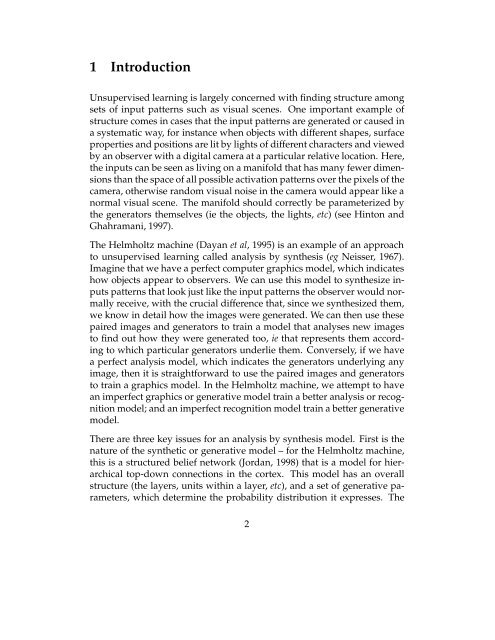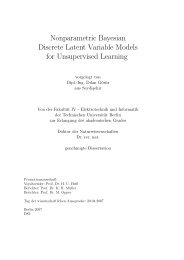Helmholtz Machines and Wake-Sleep Learning - Gatsby ...
Helmholtz Machines and Wake-Sleep Learning - Gatsby ...
Helmholtz Machines and Wake-Sleep Learning - Gatsby ...
Create successful ePaper yourself
Turn your PDF publications into a flip-book with our unique Google optimized e-Paper software.
1 Introduction<br />
Unsupervised learning is largely concerned with finding structure among<br />
sets of input patterns such as visual scenes. One important example of<br />
structure comes in cases that the input patterns are generated or caused in<br />
a systematic way, for instance when objects with different shapes, surface<br />
properties <strong>and</strong> positions are lit by lights of different characters <strong>and</strong> viewed<br />
by an observer with a digital camera at a particular relative location. Here,<br />
the inputs can be seen as living on a manifold that has many fewer dimensions<br />
than the space of all possible activation patterns over the pixels of the<br />
camera, otherwise r<strong>and</strong>om visual noise in the camera would appear like a<br />
normal visual scene. The manifold should correctly be parameterized by<br />
the generators themselves (ie the objects, the lights, etc) (see Hinton <strong>and</strong><br />
Ghahramani, 1997).<br />
The <strong>Helmholtz</strong> machine (Dayan et al, 1995) is an example of an approach<br />
to unsupervised learning called analysis by synthesis (eg Neisser, 1967).<br />
Imagine that we have a perfect computer graphics model, which indicates<br />
how objects appear to observers. We can use this model to synthesize inputs<br />
patterns that look just like the input patterns the observer would normally<br />
receive, with the crucial difference that, since we synthesized them,<br />
we know in detail how the images were generated. We can then use these<br />
paired images <strong>and</strong> generators to train a model that analyses new images<br />
to find out how they were generated too, ie that represents them according<br />
to which particular generators underlie them. Conversely, if we have<br />
a perfect analysis model, which indicates the generators underlying any<br />
image, then it is straightforward to use the paired images <strong>and</strong> generators<br />
to train a graphics model. In the <strong>Helmholtz</strong> machine, we attempt to have<br />
an imperfect graphics or generative model train a better analysis or recognition<br />
model; <strong>and</strong> an imperfect recognition model train a better generative<br />
model.<br />
There are three key issues for an analysis by synthesis model. First is the<br />
nature of the synthetic or generative model – for the <strong>Helmholtz</strong> machine,<br />
this is a structured belief network (Jordan, 1998) that is a model for hierarchical<br />
top-down connections in the cortex. This model has an overall<br />
structure (the layers, units within a layer, etc), <strong>and</strong> a set of generative parameters,<br />
which determine the probability distribution it expresses. The<br />
2
















